Backswing
Jim Hardy believes there are a
few fundamentals that must be performed properly that differ significantly
from that of a two plane swing. Hardy firmly believes that there are
no interchangable parts between the two swings, he calls them oil and
water. However, if this were true, every golfer on the PGA Tour would
neatly fall into one or the other and strictly follow Hardy's fundamentals.
Of course, this is simply not the case and almost every golfer on tour
is more of a hybrid than anything else. If you are looking for the purest
demonstration of Hardy's ideas of a one plane swing, I highly recommend
you study Peter Jacobsen's swing, as well as Scott McCarron. Of course,
you will notice that not very many other golfers' swings look like Jacobsen
or McCarron's, but if you want to follow Hardy to a "T", that
is where you should look. Below I will talk about the swings in more
detail and attempt to point out areas that I differ from Hardy, but
will mostly stick with Hardy's theories here so as to provide a more
complete reference of the two swings.
1. The shoulders swing on a steeper plane
The shoulders should always turn perpindicular to the spine
in either swing, this is nothing new. The spine should be tilted over
more at address in a one plane swing, which will allow the shoulders
to rotate on a steeper plane allowing the arms to swing up on plane.
Compare the two photos below of myself and David Toms. Note how David
swings the club above the shaft plane he established at address very
early in the swing. He keeps the club outside of his hands in order
to keep it from coming too far inside. This is a commonly taught position
in today's modern teaching and David performs it perfectly. You can
already see how his arms are separating from his torso in an effort
to create width. In a one plane swing, too much width is a bad characteristic
according to Hardy, so the arms swing more to the inside and across
the chest. Hogan also talked a great deal about his arms swinging across
his chest and the connection he maintained of his upper arms to his
chest throughout his swing. At this position, Hardy would like to see
the arms more into my right hip and closer to my body at this point.
I don't do that because I like for the club to flow a bit more on its
natural arc rather than pulling my arms across my chest very early with
my right arm.
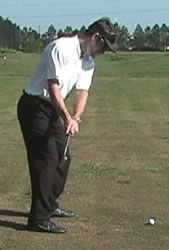 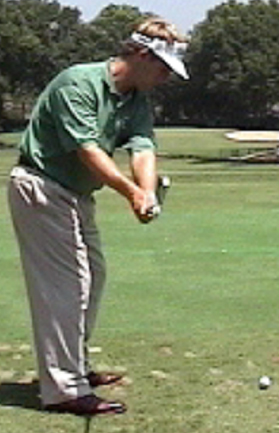
One of the very small nuances that is very important in the
one plane swing is the clockwise rotation of the left arm. David
Leadbetter pointed this out in his book on Hogan's Five Fundamentals.
In a two plane swing, there is no rotation of the forearm because you
are trying to get the club up and rotating the left arm makes the club
swing more "around" as the club goes more into the "depth"
dimension of the swing. The rotation of the arm in the one plane swing
allows the left arm to more naturally swing across the body. If you
stand up and make a baseball swing, you will notice that there is some
clockwise rotation of the left forearm. If you do not
allow the left forearm to rotate, the club will be "maneuvered"
onto a more upright plane rather than being allowed to "swing"
on it's natural, more "around" plane. This
is not something that you will concsiously do if you allow yourself
to make a natural swing, it is something that will happen on its own.
I simply point it out here because you have likely heard not to allow
the left forearm to rotate, which is true for a two plane swing, but
not true for a one plane swing. The problem is see most, however, is
with people over doing this move and getting the club too far behind
their hands and body and swinging the club on too much around. So don't
overdo it, simply allow your left arm to rotate slightly on the backswing.
2. The left arm stays connected to the chest and rotates
One of Hardy's key fundamentals is to keep the arms in close
to the body with the left arm connected to the chest. The left arm staying connected to the chest
is a key element in a one plane swing that allows the body to control
the arms - a key to power and accuracy. As I mentioned,
Hogan talked about this in his book, Five Fundamentals. Both arms stay
close to the body to decrease width and give control of the golf club
over to the torso, removing the responsibility from the much more difficult
to control arms. This allows you to use the big muscles of your body
to swing the club because the arms are a completely unreliable source
of power and control. This swinging motion happens naturally because
the arms are simply being led by the rotating body and are being allowed
to swing back behind the chest similar to a baseball swing. You can
clearly see here that David's arms are continuing their very upward
movement whereas mine are swinging more around behind me. A
simple way to look at this is that in a one plane swing the arms and
body are more in sync, with the arms naturally swinging with the rotation
of the body on the same plane. In the two plane swing the body rotates
and the arms lift. Hardy differs here a fair bit and you will see that
as the arms reach this 9 o'clock position that the shaft will be more
upright and pointing at a place somewhere between the golfer's feet
and the ball. My shaft points directly at the ball, as does Toms, although
my hands are much deeper at this point.
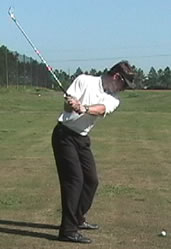 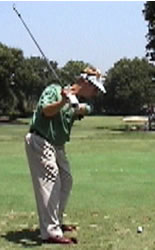
3. The arms swing back
on the same plane as the shoulders
This is where Hardy and Hogan differ significantly from today's
teaching. Both speak of how the left arm swings on a plane that is very
close to parallel to that of the shoulders. In order to do this, you
may feel that you are swinging much more around than up. The club is,
however traveling up due to the steeper shoulder plane established at
address. You'll find that it feels very natural to swing around your
body without lifting your arms. It is just how you would swing a baseball
bat or an axe if you were chopping a tree.
Observe the photo below of Steve Flesch from 2003, before he started
to work with Butch Harmon on swinging more upright, or more on two planes.
At the top of the swing, his left arm and shoulders are perfectly on
plane together.
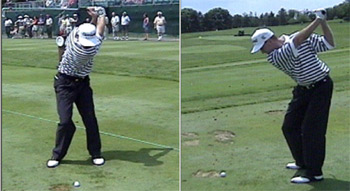
Top of the Swing
Compare the following two photos of me and David
Toms. Both of us have arrived in solid positions at the top, but there
are obvious differences. First, David's hands are directly above his
right shoulder, a textbook position for a two plane swing. My hands
are outside my right shoulder and are further "behind" my
body, as Hardy would put it. Toms' right arm has swung up and away,
disconnecting from his body, whereas mine has stayed in a bit closer.
It should be noted that Hardy wants the right elbow pointing back behind
you, similar to the photo above of Steve Flesch. I like to keep my arms
in a bit closer to my torso for a more connected feeling more similar
to Ben Hogan. Also, note the flatter shoulder plane that David has at
the top of the swing.
Many people have said to me that I look "laid off" at the
top of the swing much the way Ben Hogan used to look. However, this
is NOT a laid off position. In the picture below, the club is perfectly
on plane with my left arm and shoulders. Because of the more around
nature of the swing, the only way the club would point at the target
to not "look" laid off would be if I made a bigger shoulder
turn or increased my wrist cock. I could also manipulate the club with
my hands to point the club at the target by rotating my left forearm
counterclockwise - all of which would be completely unnecessary movements.
At this point, I've simply swung the club on an arc with no manipulations.
On the downswing, David's arms must drop a great distance to get back
on plane. He must delay his body turn until his arms have dropped back
in front of his chest. My arms do not have to drop because they are
already on plane with my shoulders. My only task from here is to rotate
my body back to the left - or "swing left" as Jim Hardy puts
it, with the whole body while rotating my shoulders on the same plane.
Hogan talked about how hard he drove with his lower body in his book
and in Jody Vasquez' book "Afternoons with Mr. Hogan" (a great
read, btw) he talked about how one of Hogan's secrets was to drive his
right knee "into the back of the ball." For most, this causes
them to come out of posture so driving with the hips is something that
must be done with caution and a smooth transition. Hardy doesn't want
a golfer to drive much with the hips, he states that they should be
allowed to turn slightly from the top to initiate the downswing. I have
no problem with a golfer turning his hips agressively as long as it
works with all the other pieces of his or her swing.
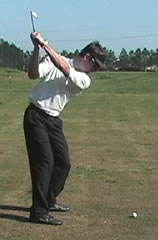 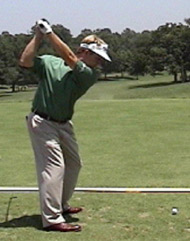
In order to arrive in this one plane
position at the top, the arms must stay connected to the body, although
Hardy would rather see the right arm pointing more behind me. The right
forearm pointing straight down at the ground is a very Hoganesque positiong
that I think provides a golfer with a significant amount of control
over the club. You can see that you could place a headcover under each
of my arms and they would stay securely in place throughout the swing.
My visual is that my left arm is velcroed to my chest. I like this image
because velcro gives a little, allowing for some feeling in the arm,
but it also gives me the feeling that my arm is securely held in place
without me "holding" it in place by being tense. I believe
that the arm must be allowed to swing into this position, not be forced
into it. You should feel as if you are in a very connected and powerful
position at the top of the swing, all the while feeling alive and dynamic.
Transition
The transition in any golf swing is perhaps the most
important move and the most difficult for most to understand. It is
what gives a golf swing its athleticism, grace and power. In both swings,
the body must begin moving back to the target before the club reaches
the top of swing. In any good golf swing, the arms do nothing active
from the top of the swing until they get back down to atleast hip high,
this allows them to store potential energy to be used exclusively through
the hitting area. The longer they stay passive, the better, as this
allows the body to control the club rather than the arms.
The transition is the single most important move for storing power in
the golf swing. It is the transition that allows the golfer to maintain
lag in the wrists that allow the club to whip through impact with little
apparent effort from the body. Ben Hogan was, of course, the absolute
master of this. Hogan began moving his body back to the target very
aggressively well before he reached the top of the swing and he, himself,
stressed the emphasis of getting the hips moving while the arms stay
passive. Hogan said that his "arms were getting a free ride."
For many, getting the lower body to move in one direction while the
club continues to move back is a difficult task. One way I teach this
move is this that as long as the club is moving back away from the target
on the backswing, the body can be rotating back away from the target.
However, after the club is perpendicular to the ground, it begins moving
"back" toward the target as it approaches the top of the swing.
It is during this time that the body must be "preparing" to
move back toward the target. It does not happen this early, but if you
think of it happening in this way it will give the body time to respond
to the minds instructions while you are learning the idea. It is at
this point, when the body begins rotating back to the left that you
can't rotate your torso too fast. The jeopardy in the two plane swing
of rotating the body too fast is the don't have time to get the arms
back down on plane and they get stuck behind you. In the one plane swing,
that is the exact desired effect. You want the left arm to feel as if
it were being drug or forced through the downswing by the body. It is
as if the left arm were velcroed to the chest, very relaxed but whipping
through impact. I cannot emphasize enough the importance of the transition.
It is the transition that stretches the muscles to their fullest extent
and this stretching is what allows them to "snap" back like
a rubber band to generate tremendous speed with very little effort.
Hardy's idea of the transition differs from what I teach as he wants
the upper torso to dominate the downswing, creating a mirror image of
the backswing on the downswing. I will not go in depth on this point
here.
At impact, I want to see the lower body clearing to the left and the
shoulders open, or pointing somewhat left at impact. You can see in
the picture below that my hips have rotated more than my shoulders,
but I have maintained my spine angle.
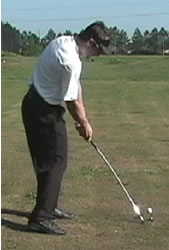
Downswing
In initiating the downswing, there are several things
to consider. The mantra of the one plane swing might be something like
"get to the left side" or "rotate the shoulders on the
same plane." While these are proper things that you need to do
in the downswing, I first will address the one thing that you must NEVER
do. It is a killer to the swing, one plane or two. Your right hip must
never, ever, under any circumstance kick your right hip toward the ball
at the start of the downswing. This move is an absolute destroyer of
all golf swings. It is such a quick, seemingly harmless motion, but
it changes more things in your downswing than any other single action.
It is a problem that plagues many, many golfers at all levels. When
the right hip kicks in toward the ball during the transition, the spine
angle changes, becoming more upright. No matter how hard you try and
maintain your spine angle, your lower back will straighten, even if
you manage to maintain the angle with your mid and upper back.
Shoulder Turn vs. Shoulder Tilt
One of the most eye opening things I thought that Hardy spoke
about was the shoulder turn/tilt. Like Hardy, I place an emphasis on
the way the shoulders rotate in the one plane golf swing. He believes,
they must rotate perpendicular to your spine at all times. If they do
not, they are tilting, not turning. On the backswing, most all better
golfers turn their shoulders rather than tilt them, but it is during
the downswing that the turning becomes more of a concern. If your right
hip moves toward the target as I mentioned above, the shoulders will
stop turning left and "tilt."
As the club moves past impact, it will begin moving immediately to the
left as it moves on its natural arc. It will not go out down the line
as many golfers have been taught for years. However, in a two plane
swing, it is ok to swing more from the inside out and releasing the
arms and hands. This will create a shot that starts right and works
back to the left, or a draw.
Follow Through
Because the swing is more rotational and around than up and down, the
finish will be more around as well. I like to see a golfer maintain
their spine angle throughout the swing and finish with the club in a
relaxed position.
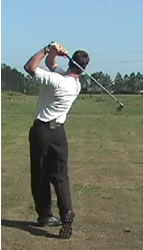
|


















